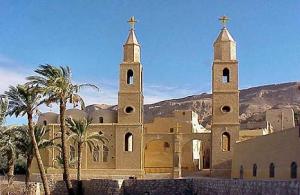St. Antony
 |
| The Coptic Monastery of Saint Anthony in Egypt |
St Antony, son of well-to-do parents, he was orphaned at the age of 18 and upon hearing the
Words of the Gospel, he gave all his possessions to the poor and placed his younger sister in a
house for virgins, and sought to live a solitary life with
God. His fame spread not only throughout
Egypt and throughout the
Roman Empire, many scholars, philosophers and emperors, including
Emperor Constantine and his sons. St Antony died at the age of 105 on
Mount Colzim; the site of the present day
Monastery of St Antony the Great, a community was formed shortly after the saint’s death in memory of him.
St Antony feast day is celebrated in the
Coptic Church on 30 January, which corresponds to 22 Tuba according to the
Coptic calendar. His life defined the nature of
monastic spirituality and became the model for all subsequent forms of
ascetic life.
St. Antony's Cave (magharah), where he lived as a solitary person, is a 2 km hike from the monastery and 680 m. above the
Red Sea. It offers stunning views of the mountains and the sea.
St. Antony's Monastery
 |
| The Coptic Monastery of Saint Anthony in Egypt |
St. Antony's Monastery (Deir Mar Antonios), and its neighbor
St. Paul's, are both
Coptic Christian and are the oldest inhabited monasteries in
Egypt. Hidden deep in the
Red Sea Mountains and relying on springs for their water supply, both still observe rituals that have hardly changed in 16 centuries.
St. Antony's Monastery, which lies at the foot of
Al-Qalzam Mountain near
Al Zaafarana, was founded in 356 AD just after the saint’s death and is the oldest active monastery in the world.
St. Antony
founded several monasteries during his life but they do not exist
anymore. During the sixth and seventh centuries, many monks from
Wadi Natroun were under frequent attacks by
Bedouins and they migrated to
St. Antony's.
This monastery was plundered on many occasions and was also partly
destroyed in the 11th century. Between the 12th and 15th centuries, the
monastery flourished but was plundered again in 1454 by
Bedouin servants. Due to such attacks, this is a
fortress style monastery. Though
Coptic today, over its many years the monastery was often multi-faith, housing monks of several different
Christian Denominations.
The Monastery
has exceptional wall paintings of holy knights in bright colors and the
hermit founders of the monastery in subdued colors and icons. These
wall paintings,
widely know to monks and art historians, were obscured by soot, candle
grease, oil and dust, but recently, in a collaborated effort between the
Supreme Council of Antiquities and the
American Research Center in Egypt, these
unique painting were restored.
- Egypt's Coptic church chooses new pope in ceremony (foxnews.com)
- Egypt's Copts to vote for Pope (bbc.co.uk)




No comments:
Post a Comment